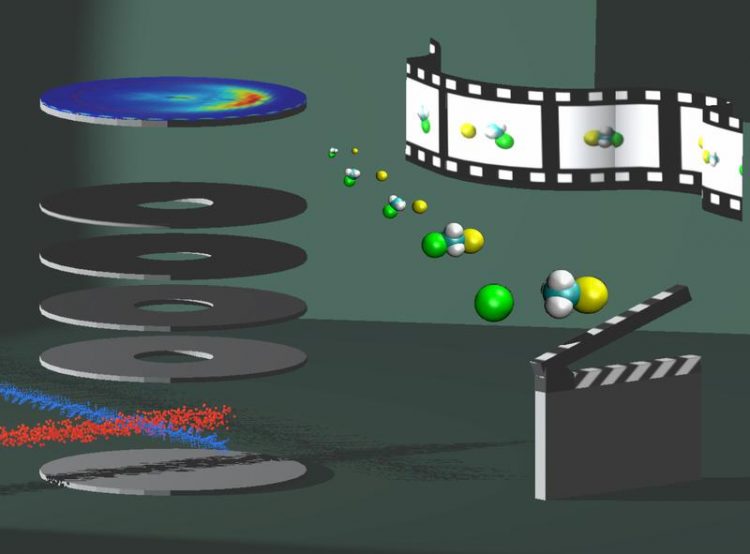Breaking the bond: To take part or not?

In a specially constructed experiment, the physicists from Innsbruck collide the charged particles with molecules in vacuum and examine the reaction products. The Royal Society of Chemistry
A frequently used reaction in organic chemistry is nucleophilic substitution. It plays, for example, an important role in in the synthesis of new chemical compounds or for biomolecules in solution and is therefore of great industrial importance.
In this reaction, charged particles encounter molecules and one molecular group is replaced by another. For a long time, science has been trying to reproduce these processes at the interface of chemistry and physics in the laboratory and to understand them at the atomic level.
The team headed by experimental physicist Roland Wester at the Institute of Ion Physics and Applied Physics at the University of Innsbruck is one of the world's leading research groups in this field.
Proton Exchange Reaction Strengthened
In a specially constructed experiment, the physicists from Innsbruck collide the charged particles with molecules in vacuum and examine the reaction products. To determine if targeted vibration excitation has an impact on a chemical reaction, the scientists use a laser beam that excites a vibration in the molecule. In the current experiment, negatively charged fluorine ions (F-) and methyl iodide molecules (CH3I) were used.
In the collision, due to the exchange of an iodine bond with a fluorine bond, a methyl fluoride molecule and a negatively charged iodine ion are formed. Before the particles meet, the laser excites carbon-hydrogen stretching vibrations in the molecule. “Our measurements show that the laser excitation does not enhance the exchange reaction,” says participating scientist Jennifer Meyer. “The hydrogen atoms just seem to be watching the reaction.”
The result is substantiated by the observation that a competing reaction strongly increases. In this other proton exchange reaction, a hydrogen atom is torn from the methyl iodide molecule and hydrogen fluoride (HF) is formed. “We let the two species collide 20 times per second, the laser is applied in every second collision, and we repeat the process millions of times,” explains Meyer.
“Whenever the laser is irradiated, this proton exchange reaction is drastically amplified.” Theoretical chemists from the University of Szeged in Hungary and the University of New Mexico in the USA have further supported the experimental results from Innsbruck using computer simulations.
Spectator Role in Focus
In high-precision investigations of chemical processes, only the simplest model, the reaction of an atom with a diatomic molecule, has so far been studied. “Here, all particles are inevitably involved in the reaction. There are no observers”, says Roland Wester. The system that we are now studying is so large that observers appear. However it is still small enough to be able to study these observers very precisely.” For large molecules, there are many particles that are not directly involved in the reaction. The investigation of their role is one of the long-term goals of the Wester group. The researchers also want to refine the current experiment in order to uncover further possible subtle effects.
Laser Controlled Chemistry
The question of whether certain reactions can be intensified by the targeted excitation of individual molecular groups is also an important consideration. “If you understand something, you can also exercise control,” sums up Roland Wester. “Instead of stimulating a reaction through heat, it may make sense to stimulate only individual groups of molecules to achieve a specific reaction,” adds Jennifer Meyer. This may avoid competing reaction processes that are a common problem in industrial chemistry or biomedical research. The more precise the control over the chemical reaction, the less waste is produced and the lower the costs.
The current paper has been published in the journal Science Advances. The research was funded by, among others, the Austrian Science Fund FWF and the Austrian Academy of Sciences.
Publication: Stretching vibration is spectator in nucleophilic substitution. Martin Stei, Eduardo Carrascosa, Alexander Doerfler, Jennifer Meyer, Balázs Olasz, Gábor Czakó, Anyang Li, Hua Guo, Roland Wester. Science Advances 2018 (Open Access) DOI: 10.1126/sciadv.aas9544
http://dx.doi.org/10.1126/sciadv.aas9544 – Stretching vibration is spectator in nucleophilic substitution. Martin Stei, Eduardo Carrascosa, Alexander Doerfler, Jennifer Meyer, Balázs Olasz, Gábor Czakó, Anyang Li, Hua Guo, Roland Wester. Science Advances 2018 (Open Access) DOI: 10.1126/sciadv.aas9544
https://www.uibk.ac.at/ionen-angewandte-physik/index.html.en – Institute for Ion Physics and Applied Physics, University of Innsbruck
Media Contact
All latest news from the category: Physics and Astronomy
This area deals with the fundamental laws and building blocks of nature and how they interact, the properties and the behavior of matter, and research into space and time and their structures.
innovations-report provides in-depth reports and articles on subjects such as astrophysics, laser technologies, nuclear, quantum, particle and solid-state physics, nanotechnologies, planetary research and findings (Mars, Venus) and developments related to the Hubble Telescope.
Newest articles

NASA: Mystery of life’s handedness deepens
The mystery of why life uses molecules with specific orientations has deepened with a NASA-funded discovery that RNA — a key molecule thought to have potentially held the instructions for…

What are the effects of historic lithium mining on water quality?
Study reveals low levels of common contaminants but high levels of other elements in waters associated with an abandoned lithium mine. Lithium ore and mining waste from a historic lithium…

Quantum-inspired design boosts efficiency of heat-to-electricity conversion
Rice engineers take unconventional route to improving thermophotovoltaic systems. Researchers at Rice University have found a new way to improve a key element of thermophotovoltaic (TPV) systems, which convert heat…



